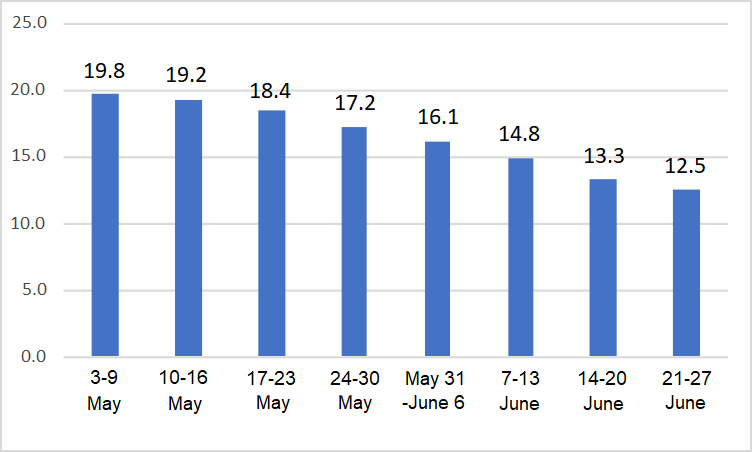PNAD COVID19: 12.5% of employed population was away from work due to social distancing between June 21-27
July 17, 2020 09h00 AM | Last Updated: July 20, 2020 10h18 AM
This proportion dropped in relation to the previous week (13.3%) and against the first week of the survey, between May 3 and 9 (19.8%).
PNAD COVID19 estimated at 82.5 million the employed population in Brazil in the week between June 21 and 27, dropping in relation to the previous week (84.0 million persons) and in relation to the week between May 3 and 9 (83.9 million persons). Among them, 8.6 million (or 12.4% of the employed persons) worked remotely, a contingent that remained statistically stable in relation to the previous week (8.7 million or 12.5%) and also in relation to the week between May 3 and 9 (8.6 million or 13.4%).
The employment-population ratio was 48.5%, dropping against the previous week (49.3%) and in relation to the week between May 3 and 9 (49.4%).
The proxy of the informality rate was 34.5%, stable in relation to the previous week (33.9%) and declining against the week between May 3 and 9 (35.7%).
Nearly 10.3 million (12.5% of the employed population) were away from work due to social distancing. This contingent reduced in relation to the previous week (11.1 million or 13.3% of the employed population) and also against the week between May 3 and 9 (16.6 million or 19.8% of the employed persons).
Percentage of employed persons away from work due to social distancing in relation to the overall employed population in the reference week - Brazil (%)

The unemployed population was estimated at 12.4 million persons and remained statistically stable against the previous week (11.7 million), though it increased in relation to the week between May 3 and 9 (9.8 million). As a result, the unemployment rate stayed at 13.1% for the period between June 21 and 27, a rise over the previous week (12.3%) and over the first week of May (10.5%).
The workforce participation rate stayed at 55.8% between June 21 and 27, which indicated a stability in relation to the previous week (56.2%) and an increase compared with the first week of May (55.2%).
Conversely, the population out of the workforce – that was neither working nor searching for work – was of 75.1 million persons, a statistical stability in relation to the previous week (74.5 million) and to the week between May 3 and 9 (76.2 million). In this population, nearly 26.9 million persons (or 35.9% of the population out of the workforce) said that they would like to work. This contingent remained stable in relation to the previous week (26.4 million or 35.4%) and against the week between May 3 and 9 (27.1 million or 35.5%).
Nearly 17.8 million persons out of the workforce, who would like to work and did not search for a job, did not do it because of the pandemic or for not finding a job in the locality where they lived. They corresponded to 66.2% of the unemployed persons who did not search for a job and would like to work. This contingent remained stable over the previous week (17.3 million or 65.8%), though it dropped compared with the week between May 3 and 9 (19.1 million or 70.7%).
3.1 million persons with symptoms of flu syndrome looked for health establishments
In the week between June 21 and 27, PNAD COVID19 estimated that 15.4 million persons (or 7.3% of the Brazilian population) showed at least one of the 12 symptoms associated to the flu syndrome (fever, cough, sore throat, difficulty to breathe, headache, chest pain, nausea, stuffy or runny nose, fatigue, eye pain, loss of smell or taste, and muscle pain) which are investigated by the survey. This contingent remained stable against the previous week (15.3 million or 7.2% of the population) and dropped in relation to the week between May 3 and 9 (26.8 million or 12.7%).
Nearly 3.1 million persons (or 20.0% of those who showed some symptom) looked for medical care in health establishments (health centers, family health teams, UPAs, SUS medical centers or hospitals, or even private ambulatories/offices, medical centers or hospitals). This contingent remained stable in relation to the previous week (3.1 million or 20.1%), though it dropped in absolute numbers against the week between May 3 and 9 (3.7 million or 13.7%). More than 85% of these attendances were in the public health network.
Between June 21 and 27, 322 thousand persons (10.4%) who had symptoms of flu syndrome looked for medical care in private or military ambulatories or offices. Such proportion represented a stability both in the comparison with the previous week (440 thousand or 14.3%) and in relation to the first week of May (320 thousand or 8.7%).
Nearly 982 thousand persons looked for medical care in public, private or military hospitals in the week between June 21 and 27. This contingent remained statistically stable in relation to the previous week (976 thousand) and against the week between May 3 and 9 (1.1 million). Among those who looked for medical care, 119 thousand (12.2%) were hospitalized. In this case, it also remained stable against the previous week (110 thousand or 11.3%) and the week between May 3 and 9 (97 thousand or 9.1%).

